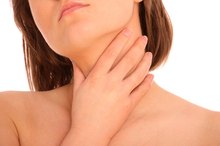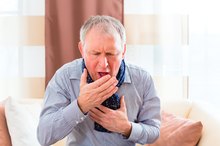What does fact checked mean?
At Healthfully, we strive to deliver objective content that is accurate and up-to-date. Our team periodically reviews articles in order to ensure content quality. The sources cited below consist of evidence from peer-reviewed journals, prominent medical organizations, academic associations, and government data.
The information contained on this site is for informational purposes only, and should not be used as a substitute for the advice of a professional health care provider. Please check with the appropriate physician regarding health questions and concerns. Although we strive to deliver accurate and up-to-date information, no guarantee to that effect is made.
Esophageal Erosion Symptoms
Esophageal erosion is a medical term to specify the wear and tear on the esophagus, the tube in the throat that leads from the mouth to the stomach. In most cases, this condition is caused by digestive issues, the most common of which is GERD, or gastroesophageal reflux disease. This disease causes stomach acids to back-up into the esophagus because the sphincter or flap that covers the opening between the esophagus and the stomach does not close properly. The constant flush of stomach acids in the esophagus may cause damage to the tube that results in a gradual erosion of the lining, causing a variety of symptoms.
If you are experiencing serious medical symptoms, seek emergency treatment immediately.
Inflammation
Inflammation of the esophagus is caused by mild to moderate states of acid reflux from the stomach back up into the esophagus. The lining or mucous membrane of the swallowing tube becomes red and irritated, causing a burning sensation along portions or the entire length of the esophagus. This symptom is most commonly called heartburn or acid indigestion.
- Inflammation of the esophagus is caused by mild to moderate states of acid reflux from the stomach back up into the esophagus.
- The lining or mucous membrane of the swallowing tube becomes red and irritated, causing a burning sensation along portions or the entire length of the esophagus.
Stricture
Symptoms of GERD in Women
Learn More
In some cases of esophageal erosion, inflammation may lead to swelling of the tissues lining the esophageal tube. This swelling can cause narrowing of the passageway, making it difficult to swallow foods and even saliva. The erosion of the esophagus may occur at any point along the tube.
Ulcers
Ulcers or holes in the lining of the esophagus are also common symptoms of erosion. These ulcers are one of the rarest form of ulcers and usually occur near the bottom of the esophagus. Ulcers may also be caused by a bacteria called H. pyloridus bacteria as well as GERD. However, individuals who suffer from bulimia, as well as individuals who smoke and drink, may also experience these types of ulcers in the esophagus lining.
- Ulcers or holes in the lining of the esophagus are also common symptoms of erosion.
Pain
Pyloric Ulcer Symptoms: Edema, Abdominal Pain When Sitting
Learn More
Pain caused by esophageal erosion is often expressed by individuals as a constant burning or warm sensation marked by sharp episodes of pain when swallowing. Others suffering from varying degrees of erosion in the esophagus may experience pain caused by coughing, and may even note the presence of the blood in sputum or mucous.
Bleeding
Individuals suffering from esophagus erosion may experience bleeding, which, in severe cases, may also be noted in the stools as a dark and tarry looking substance. Vomiting caused by stomach upset may also be tinged with blood or a person may even vomit blood. This is a severe symptom that requires immediate attention.
Tooth Decay
As the erosion of the esophagus advances, other parts of the digestive system, including the mouth and teeth, may be affected. If left untreated, teeth enamel may suffer from acid regurgitation.
Related Articles
References
- Ajayi TA, Cantrell S, Spann A, Garman KS. Barrett’s esophagus and esophageal cancer: Links to microbes and the microbiome. PLOS Pathogens. 2018;14(12). doi:10.1371/journal.ppat.1007384
- Ferhatoglu MF, Kıvılcım T. Anatomy of Esophagus. Esophageal Abnormalities. June 2017. doi:10.5772/intechopen.69583
- Grossi L, Ciccaglione AF, Marzio L. Esophagitis and its causes: Who is "guilty" when acid is found "not guilty"? World J Gastroenterol. 2017;23(17):3011-3016. doi:10.3748/wjg.v23.i17.3011
- Hong YS, Min YW, Rhee PL. Two Distinct Types of Hypercontractile Esophagus: Classic and Spastic Jackhammer. Gut Liver. 2016;10(5):859-63. doi:10.5009/gnl15388
- Napier KJ, Scheerer M, Misra S. Esophageal cancer: A Review of epidemiology, pathogenesis, staging workup and treatment modalities. World J Gastrointest Oncol. 2014;6(5):112-20. doi:10.4251/wjgo.v6.i5.112
- Yin A, Li Y, Jiang Y, Liu J, Luo H. Mallory-Weiss syndrome: clinical and endoscopic characteristics. Eur J Intern Med. 2012;23(4):e92-6. doi:10.1016/j.ejim.2012.02.005
- Søreide JA, Viste A. Esophageal perforation: diagnostic work-up and clinical decision-making in the first 24 hours. Scand J Trauma Resusc Emerg Med. 2011;19:66. doi:10.1186/1757-7241-19-66
- Meseeha M, Attia M. Esophageal Varices. [Updated 2019 Feb 1]. In: StatPearls [Internet]. Treasure Island (FL): StatPearls Publishing; 2020 Jan-.
- Pandolfino JE, Gawron AJ. Achalasia: a systematic review. JAMA. 2015;313(18):1841-52. doi:10.1001/jama.2015.2996
- Carucci LR, Turner MA. Dysphagia revisited: common and unusual causes. Radiographics. 2015;35(1):105-22. doi:10.1148/rg.351130150
- Slawik M, Beuschlein F, Light K, et al. Odynophagia. Encyclopedia of Molecular Mechanisms of Disease. 2009:1512-1514. doi:10.1007/978-3-540-29676-8_1313
- Shaheen NJ, Falk GW, Iyer PG, Gerson LB. ACG Clinical Guideline: Diagnosis and Management of Barrett's Esophagus. Am J Gastroenterol. 2016;111(1):30-50. doi:10.1038/ajg.2015.322
- American Cancer Society. What is Cancer of the Esophagus?
- Harrison's Principles of Internal Medicine, 20th Edition. McGraw-Hill Education. 2018.
- U.S. National Library of Medicine. MedlinePlus. Esophagus Disorders.
Writer Bio
Denise Stern is an experienced freelance writer and editor. She has written professionally for more than seven years. Stern regularly provides content for health-related and elder-care websites and has an associate and specialized business degree in health information management and technology.








